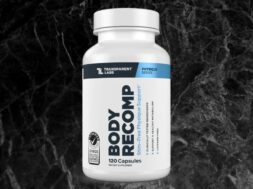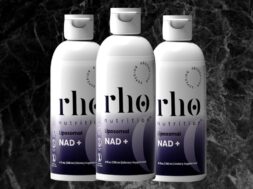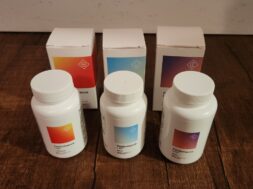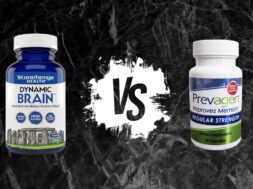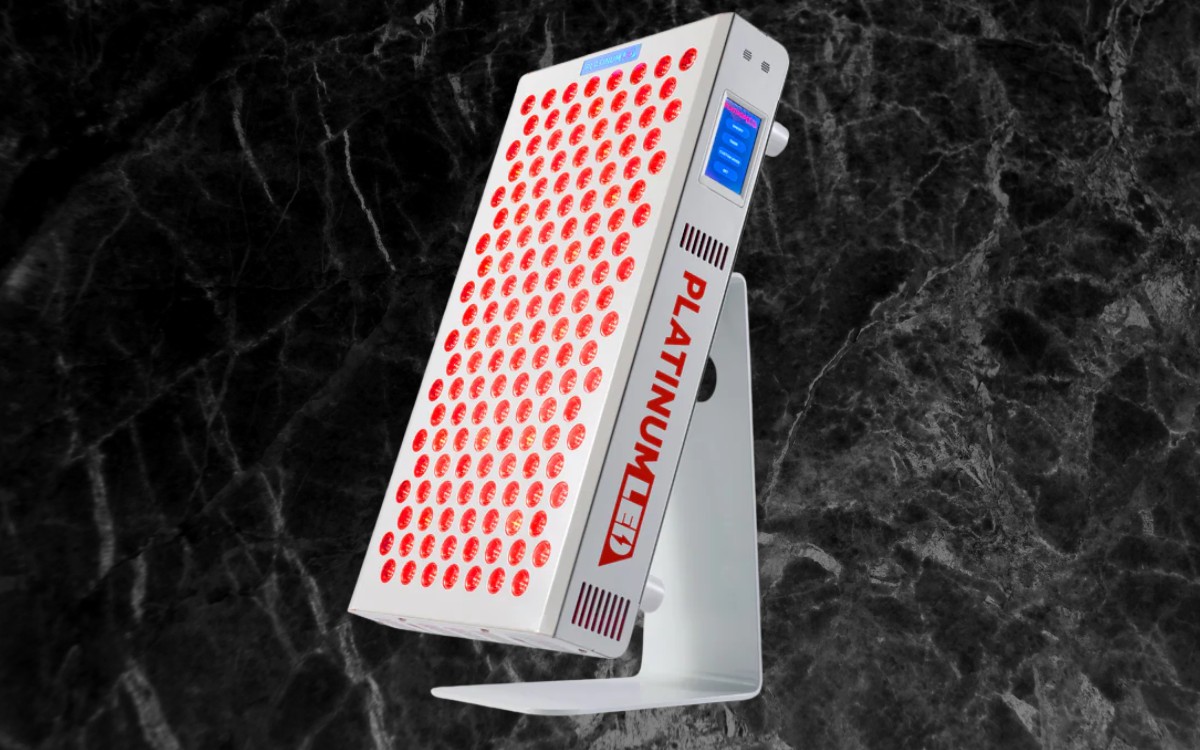
I’ve been using red light therapy for years as part of my recovery routine. Between weightlifting, grappling, and long workdays, it’s one of those tools that’s quietly earned its place.
I’ve tested a lot of devices over time, from compact wraps to full-sized panels, and I’ve seen firsthand how much difference consistency and light quality can make.
So when the Platinum LED BioMax series kept popping up in athlete circles and recovery online groups, I decided to test it for myself. I already knew what red and near-infrared light can do, but I wanted to see whether this specific system actually delivered on its claims of higher power and professional-grade performance.
For the past month, I’ve been using the BioMax 300, the smallest panel in the lineup, as part of my post-training and evening recovery sessions. In this review, I’ll share how this panel fits into a routine that already includes regular red light use, and smart training.
Let’s take a closer look at what the BioMax does well, where it falls short, and how it compares to other top-tier options I’ve tested.
Quick Verdict
After a month with the Platinum LED BioMax 300, I can say this: it’s one of the strongest and most flexible red light panels on the market, but it demands space, time, and consistency.
The BioMax delivers a powerful combination of red (630/660nm) and near-infrared (810/830/850/1060nm) light.
Output and build quality are impressive. It’s a serious piece of gear, not a toy. But these benefits also create the downsides.
It’s big, heavy, and not something you’ll casually move around. You have to commit a bit of routine and space to make it part of your life.
If you want a full-body or multi-area recovery system, the BioMax delivers professional-grade power in a home setup.
But if your main goal is joint or tendon pain relief, I still recommend the Kineon Move+ Pro. It’s portable, targeted, and far easier to use consistently, which usually means better results in the long run.
Pros
- Serious power output — delivers clinical-grade intensity with strong coverage even from a distance.
- Independent red and NIR control, allowing you to fine-tune for skin or deep-tissue sessions.
- Solid, durable build — metal housing, stable design, and built to last.
- Multiple size options — from the compact 300 to the full-body 900, you can scale it to your setup.
- Clear and reliable timer settings that make daily use simple and repeatable.
Cons
- Bulky and stationary — not something you’ll move around or use casually.
- Expensive upfront — especially compared to targeted devices or smaller panels.
- No internal battery, so it must stay plugged in (limits flexibility).
- Return policy isn’t great — 20% restocking fee and customer pays return shipping.
- Requires consistency — you won’t see benefits if it gathers dust in the corner.
What Is The Platinum LED Biomax?
The Platinum LED BioMax series is a family of high-intensity red and near-infrared light therapy panels designed for home or clinical use. They’re built for people who want the kind of output you’d find in a rehab or performance clinic, not a handheld gadget.
The company has been around since 2014, and the BioMax line represents their latest generation of panels with improved optics, modular design, and an expanded wavelength range.
Unlike smaller consumer devices that focus on one or two wavelengths, the BioMax lineup combines six distinct wavelengths:
- 630 nm and 660 nm red light for surface-level effects such as skin health, collagen, and circulation.
- 810 nm, 830 nm, 850 nm, and 1060 nm near-infrared light for deeper penetration into muscles, tendons, and joints.
This mix allows you to target both superficial and deep tissue in the same session. You can control red and NIR independently with separate switches, which means you can use only the spectrum you need, depending on the goal of your session.
The build quality is what you’d expect from a premium system: full metal housing, integrated cooling fans, and solid LED diodes rated for 50,000+ hours. The panels are not wireless, they’re plug-in units that draw significant power, which is part of why they can output more energy than most compact lights.
The BioMax lineup comes in four main sizes:
| Model | Coverage | Price (USD) | Ideal Use |
| BioMax 300 | ~10″ x 9″ area | $659 | Focused therapy for one joint or small muscle group |
| BioMax 450 | ~18″ x 9″ area | $799 | Mid-size for upper body or legs |
| BioMax 600 | ~36″ x 9″ area | $1,049 | Torso-length coverage |
| BioMax 900 | ~36″ x 18″ area | $1,299 | Full-body panel setup |
I’ve been testing the BioMax 300, which is the smallest and most practical for single-area use. It’s still heavy compared to a portable unit, but manageable at roughly the size of a large laptop bag, with about a 10-minute setup time from box to use.
What stands out about the BioMax is the raw intensity and engineering. Platinum LED claims the highest irradiance of any consumer panel, and while independent lab measurements can vary, there’s no question the device delivers powerful output when you’re within the recommended range (typically 6–12 inches from the surface).
Platinum LED Biomax Review
Performance and Effectiveness
The first thing you notice about the BioMax 300 is its intensity. Once it powers on, it floods the room with deep red light, and you instantly feel you’re using something built for real output, not spa-level ambiance. I used it for about a month, mainly on my knees, elbows, and lower back, the areas that usually feel beat up after heavy training or grappling.
Most of my sessions were around 12–15 minutes, at roughly 8–12 inches distance, with the NIR mode taking priority for joint and muscle recovery. Within the second week, I began experiencing the expected steady reduction in stiffness, especially after squats or long mat sessions. Soreness didn’t vanish completely, but recovery between workouts was smoother and less “sticky.”
The BioMax’s multi-wavelength system (630–1060 nm) seems to make a real difference in depth of effect. Red light hits surface tissues, while the near-infrared penetrates deeper, supporting muscle and connective tissue repair. That’s what separates it from cheaper lights that rely only on visible red LEDs.
Like most recovery tools, though, the magic is in consistency. If you use it three to five times a week, you’ll notice subtle but real gains in comfort and recovery. Skip it for a few days, and you’re back where you started.
Design and Build Quality
This thing feels built to last. The metal housing gives it a sturdy, professional feel, and the cooling fans keep temperatures stable even during long sessions. It’s not whisper-quiet, but the fan noise is closer to a small desktop fan than gym equipment. The panel has a clean, matte finish with solid seams and no cheap plastic anywhere.
Even the smaller 300 model carries some weight. It’s compact enough to hang from a door or stand on a table, but you’ll quickly realize it’s not something you’ll want to move every day. Once you find a setup, whether on a wall mount or door hook, you’ll leave it there. The LEDs are evenly distributed and project light across a surprisingly broad area for its size.
Ease of Use
For something that looks like lab equipment, the BioMax is refreshingly simple. You plug it in, choose whether you want red, NIR, or both, set the timer, and go. There’s no app or Wi-Fi pairing nonsense, just straightforward functionality.
The panel heats up slightly during use but never uncomfortably so, and you don’t need to wear goggles unless you’re working close to your face. I preferred to use it in the evenings, post-shower, when recovery mode already felt like part of the day’s wind-down. The hardest part is just staying still. Fifteen minutes feels long when you’re balancing fatherhood and a packed schedule.
Once you make it routine, though, it’s easy to fit in. The timer shuts the panel off automatically, so you can literally set it and walk away when it’s done.
Battery Life and Hardware
Unlike portable red light devices, the BioMax panels don’t run on batteries, they’re plug-in only. That might sound limiting, but it’s also what gives them their power advantage. Battery-operated devices can’t deliver the same sustained output without overheating or draining quickly.
The power supply is robust, with stable voltage and built-in protection against surges. The internal cooling system uses multiple quiet fans that run automatically during operation. After longer sessions, the panel stays warm but never hot, which speaks to solid thermal design.
There’s no onboard battery to wear out, so lifespan mainly depends on the LEDs themselves, which are rated for around 50,000 hours. If you’re looking for something portable and cordless, this isn’t it. But if you want raw, consistent power, the plug-in design is part of what makes it effective.
Price
The BioMax lineup sits firmly in the premium bracket — you’re paying for high output, multiple wavelengths, and industrial build quality. It’s not cheap, but it’s not overpriced for what it delivers either. Here’s the breakdown:
| Model | Price (USD) | Ideal Use |
| BioMax 300 | $659 | Focused therapy for joints or small muscle areas |
| BioMax 450 | $799 | Mid-size panel for legs or torso |
| BioMax 600 | $1,049 | Full torso or half-body coverage |
| BioMax 900 | $1,299 | Complete full-body setup |
Even the smallest BioMax 300 packs serious power, so unless you’re looking for a full-body rig, it’s enough for most athletic recovery use. Still, this is an investment. It makes the most sense for people who’ll actually use it several times a week, otherwise, it’s expensive décor.
How To Use The Platinum LED Biomax Red Light Panel
1. Setup and Positioning
Mount or place the panel so it’s stable and aimed directly at the area you’re targeting. For deep tissue or joint work, stay about 6–12 inches away; for skin or surface treatments, 12–18 inches is ideal. The panel can be mounted vertically on a door or wall, or used on a stand for easier positioning.
2. Session Duration
Start with 10–12 minutes per area, up to 20 minutes for larger muscle groups. Beginners can use it every other day for the first week, then move to 3–5 sessions per week as your body adapts.
3. Light Settings
Use red + NIR combined for full recovery sessions. Switch to red only for skin health or superficial issues, and NIR only for deeper joints and muscles. The independent switches make this easy — experiment to see which combo feels best.
4. Consistency Is Everything
The benefits build over time. Sporadic use won’t do much, but regular exposure for 3–4 weeks typically brings noticeable improvements in recovery, soreness, and general energy.
5. Safety Notes
Avoid looking directly at the LEDs up close, especially in red mode. Eye protection is optional but recommended for longer sessions. The panel gets warm but shouldn’t feel hot. If it does, step back or shorten the session.
Platinum LED Biomax Benefits
Faster Muscle Recovery
One of the main reasons athletes and lifters turn to red light therapy is recovery.
Red and near-infrared light at the wavelengths used in the BioMax (630–850 nm) stimulate the mitochondria inside muscle cells, helping them produce more ATP, the body’s main energy currency. More ATP means faster repair, reduced soreness, and less downtime between workouts.
In practice, that translates to muscles that feel less “heavy” the next day and a quicker return to baseline strength after hard sessions. Clinical studies back this up, with multiple trials showing improved recovery and reduced muscle fatigue when red light therapy is applied within 24 hours of training.
If you’re training several days a week, the BioMax won’t erase soreness, but it helps you recover smoother and with fewer of those lingering aches that build up over time.
Reduced Joint Pain and Inflammation
The most noticeable effect I’ve seen, and what many users report, is in joint comfort. Knees, elbows, shoulders, even the lower back respond well to near-infrared light.
NIR wavelengths penetrate several centimeters beneath the skin, where they help regulate inflammatory processes and increase local blood flow. That combination often results in less stiffness and pain, especially with chronic overuse injuries.
Studies on arthritis and tendon recovery support this. NIR therapy has been shown to decrease inflammatory markers and stimulate collagen regeneration in connective tissue. The BioMax’s inclusion of 810, 830, 850, and 1060 nm wavelengths gives it excellent depth for this kind of work.
Improved Circulation and Energy
Another underrated benefit of red light therapy is improved microcirculation, or the small blood flow networks that feed muscles and skin. Enhanced circulation means better oxygen and nutrient delivery and more efficient waste removal after intense effort.
On a subjective level, many people (myself included) feel a slight energy lift after sessions. That comes from the light’s influence on both blood flow and mitochondrial performance.
This isn’t a substitute for good nutrition or sleep, but it complements them well. Over time, better circulation and oxygenation help your body stay in a more efficient recovery rhythm.
Who Is Platinum LED Biomax For?
Athletes and Lifters Focused on Recovery
If you’re training several times a week, lifting, running, grappling, or doing any sport that taxes your joints and soft tissue, the BioMax can make a noticeable difference. The increased blood flow, improved cellular energy, and anti-inflammatory effects add up over time.
Think of it as a passive recovery tool: you don’t need to move, stretch, or do anything complicated. Just stand or sit in front of it for fifteen minutes. For serious athletes or weekend warriors pushing their limits, that’s a low-effort way to support recovery and longevity.
Men Dealing with Chronic Joint or Back Pain
Even if you’re not chasing PRs anymore, years of heavy lifting or manual work leave their mark. The BioMax is well-suited for guys managing recurring joint or back pain, especially in the knees, shoulders, and lower spine.
Near-infrared light penetrates deep enough to reach connective tissue and muscle fascia, helping reduce inflammation and stiffness. It’s not a cure-all, but it’s a tool that can make day-to-day movement feel smoother and less painful, especially when combined with good mobility and strength work.
Professionals or Parents with Limited Time
If your schedule is packed and you can’t fit in long recovery sessions, the BioMax is ideal. It’s plug in, switch on, and done — no prep, no noise, no cleanup. You can use it while reading emails, listening to podcasts, or winding down before bed.
For dads, executives, or anyone balancing training with work and family life, this simplicity is a real advantage.
Who It’s Not For
If you’re expecting dramatic results from occasional use, you’ll probably be disappointed. The BioMax requires discipline and consistency with a few sessions a week, every week. It’s also not for those looking for portability or spot treatment on the go; it’s a stationary unit that belongs in a fixed setup.
It’s also not the right buy if you’re mainly after targeted joint recovery. In that case, a device like the Kineon Move+ does a better job since it’s mobile, strap-on, and easier to use daily. The BioMax shines when you want broad, multi-area therapy, not single-joint convenience.
My Experience Using Platinum LED Biomax
I used the BioMax 300 for about a month, mostly on my knees, lower back, and shoulders. Between lifting, grappling, and chasing my kids around, those are the areas that usually complain first. My setup was simple — I mounted the panel on a door, set it at about chest height, and ran 12–15 minute sessions in the evening, three to five times a week.
The first thing that stood out was how strong the light feels. After a few sessions, you notice the warmth penetrating deep into the tissue. Within a couple of weeks, my knees felt less “creaky” in the mornings, especially after heavy squats or long jiu-jitsu rolls. My lower back felt looser, and I found myself recovering faster between sessions.
What I liked most was how low-effort it became once the routine was in place. You don’t need to focus, stretch, or think about form, you just stand there and let it work. I often used it while watching training footage or podcasts. That made it easy to stay consistent, and consistency is where the benefits really showed up.
There were a few small drawbacks. The panel is heavier than I expected, and setting it up in a permanent spot took some trial and error. The fan makes a low hum, which is not loud, but noticeable if the house is quiet. And of course, the time commitment adds up; it’s not something you do on the run.
After a month, I wouldn’t call the results dramatic, but they were steady and real. My joints felt healthier, my energy was slightly better in the mornings, and recovery between workouts became more predictable. The BioMax doesn’t replace sleep, diet, or good training habits, but it complements them well.
Customer Platinum LED Biomax Reviews
Overall, user feedback on the BioMax line is mostly positive, especially from people who use it consistently for recovery or chronic pain. Many owners praise its powerful output, solid build quality, and visible improvements in joint comfort and energy after a few weeks of regular use.
A verified buyer on Reviews.io wrote, “It eases the joints almost immediately — I can bend my forefinger more with less pain,” while another noted, “I’ve seen real gains in energy and recovery since adding this to my nightly routine.”
That said, the customer service and return process get mixed reviews. Some users on Trustpilot report slow support and frustration with the 20% restocking fee. Others mention the unit’s weight and lack of portability as downsides.
In short, when used properly and regularly, the BioMax delivers on performance, but it’s not a plug-and-play miracle, and the buying experience isn’t always perfect.
Platinum LED Biomax Alternatives
Hooga Red Light Therapy Belt
At $299, it’s built for targeted recovery like treatment of small joints, lower back, or quads after training, and it does its job well. Using the proven 660 nm red and 850 nm near-infrared wavelengths, it delivers meaningful relief for muscle soreness and mild inflammation without needing a wall mount or floor space.
The belt is lightweight, cordless, and battery-powered, giving you 4–6 sessions per charge. You can wear it while cooking, stretching, or doing chores, which makes it far easier to stay consistent than a full-size panel. The warmth it produces is gentle and soothing, though in warmer climates it can get a bit hot during long sessions.
It’s not perfect, and there are no intensity settings, no app controls, and the Velcro straps tend to fray over time. But for portability and simplicity, it’s one of the best mid-range devices I’ve tested.
If your goal is quick, localized recovery and you’re not chasing full-body exposure, the Hooga belt is a smart, budget-friendly choice. For deeper tissue or chronic joint issues, though, the Kineon Move+ still pulls ahead. My Hooga review goes into detail about my experience.
Lumebox
In testing, it performed best for muscle recovery and skin texture, especially when used consistently over 4–6 weeks. The 6- and 12-minute timer presets make dosing foolproof, and the cooling system keeps it comfortable during longer sessions. It’s plug-in only, which limits mobility but guarantees steady output every time.
The biggest upside is power in a small form; the biggest downside is that you’re tethered to an outlet. It’s great for desk setups or home recovery corners, less so if you want to move around. For active people who want a durable, portable light but not a huge panel, the Lumebox delivers solid value.
Still, for about the same money, the BioMax offers more coverage and flexibility, so the Lumebox only makes sense if you prefer the convenience of a small, precise tool over a full-scale setup.
You can read my Lumebox review for my experience.
Novaalab Light Pad
It uses 660 nm red and 850 nm NIR light and adds adjustable frequency settings (steady or pulsed 1–999 Hz), which is rare at this price point.
It’s cord-powered, so not as mobile as the Hooga, but the large silicone pad covers broad areas like the lower back, hamstrings, or shoulders effectively.
The warmth is gentle, the setup easy, and you can strap it on while reading or watching TV. Build quality feels mid-range, the controller is plasticky, and the velcro may loosen with heavy use, but performance is solid for the cost.
If you want an affordable, versatile light for home recovery and don’t need the industrial power of a BioMax, the Novaalab Pad is a safe bet. It’s a good step up from budget gadgets but not quite the powerhouse the BioMax or Lumebox represent.
My Novaalab review goes into detail about my experience.
Frequently Asked Platinum LED Biomax Questions
How long before I see results?
Most people start noticing subtle improvements like reduced joint stiffness or quicker post-workout recovery within two to three weeks of consistent use.
For skin or circulation benefits, it can take closer to a month of steady sessions.
The key is frequency: two short, focused sessions a week won’t do much. Commit to three to five 10- to 15-minute sessions per week, and the gains start to compound.
Can I use it every day?
Yes. Red and near-infrared light therapy is safe for daily use, provided you stick to the manufacturer’s timing and distance guidelines.
I often use it after evening training sessions for 10 to 15 minutes per area, without any issues.
More exposure doesn’t equal faster progress; give your cells time to respond between sessions.
Is it safe for the eyes?
You should avoid staring directly at the LEDs, especially at close range. The visible red light can cause eye fatigue over time.
For facial treatments, either close your eyes or wear light-blocking goggles. Near-infrared light is invisible but still powerful, so treat it with the same caution.
Does it get hot or cause burns?
The BioMax emits gentle warmth, not heat. The built-in cooling fans prevent any dangerous temperature rise, even during long sessions.
It shouldn’t feel uncomfortable, and if it does, you’re probably standing too close. Step back a few inches or shorten the session.
Used correctly, it won’t burn or irritate skin, even with daily use.
Can I use it through clothing?
Thin fabrics block a surprising amount of therapeutic light. For best results, use the BioMax directly on bare skin or through only a thin cotton layer if modesty or comfort is a concern.
Even one sweatshirt can reduce penetration dramatically, especially for near-infrared wavelengths designed to reach muscle and joint tissue..
Summary
After a month with the Platinum LED BioMax 300, I can say it’s one of the most capable red light panels I’ve tested. It’s powerful, well-built, and genuinely effective when used consistently.
The BioMax delivers high light intensity, clinically supported wavelengths, and serious durability. Over time, it helps ease soreness, reduce joint stiffness, and speed recovery between sessions. The benefits aren’t instant, but they’re steady and noticeable if you stick to a routine.
Still, this is a commitment device. It’s large, stationary, and best suited for people willing to dedicate space and time for proper use. If that’s you, it can become a cornerstone in your recovery setup.
If not, there are more practical options. The Hooga Belt offers simple, portable therapy for smaller areas. The Lumebox 2.0 brings impressive power in a compact form. And the Novaalab Light Pad offers flexibility and comfort for full-surface sessions at a lower cost.
That said, if you want something mobile and convenient that fits real-world training and life, the Kineon Move+ Pro remains my top pick. Its wearable, laser-LED design makes it easier to use daily, and daily use is what truly drives results.
Kineon MOVE+ Pro
Kineon MOVE+ Pro
Powerful red light therapy device designed be applied without having to sit in front of a large light panel.
CHECK CURRENT DEALS



